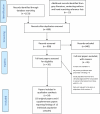Enablers and barriers to treatment adherence in heterozygous familial hypercholesterolaemia: a qualitative evidence synthesis
- PMID: 31371299
- PMCID: PMC6677970
- DOI: 10.1136/bmjopen-2019-030290
Enablers and barriers to treatment adherence in heterozygous familial hypercholesterolaemia: a qualitative evidence synthesis
Abstract
Objectives: Individuals with heterozygous familial hypercholesterolaemia (FH) are at high risk of developing cardiovascular disease (CVD). This risk can be substantially reduced with lifelong pharmacological and lifestyle treatment; however, research suggests adherence is poor. We synthesised the qualitative research to identify enablers and barriers to treatment adherence.
Design: This study conducted a thematic synthesis of qualitative studies.
Data sources: MEDLINE, Embase, PsycINFO via OVID, Cochrane library and CINAHL databases and grey literature sources were searched through September 2018.
Eligibility criteria: We included studies conducted in individuals with FH, and their family members, which reported primary qualitative data regarding their experiences of and beliefs about their condition and its treatment.
Data extraction and synthesis: Quality assessment was undertaken using the Critical Appraisal Skills Programme for qualitative studies. A thematic synthesis was conducted to uncover descriptive and generate analytical themes. These findings were then used to identify enablers and barriers to treatment adherence for application in clinical practice.
Results: 24 papers reporting the findings of 15 population samples (264 individuals with FH and 13 of their family members) across 8 countries were included. Data captured within 20 descriptive themes were considered in relation to treatment adherence and 6 analytical themes were generated: risk assessment; perceived personal control of health; disease identity; family influence; informed decision-making; and incorporating treatment into daily life. These findings were used to identify seven enablers (eg, 'commencement of treatment from a young age') and six barriers (eg, 'incorrect and/or inadequate knowledge of treatment advice') to treatment adherence. There were insufficient data to explore if the findings differed between adults and children.
Conclusions: The findings reveal several enablers and barriers to treatment adherence in individuals with FH. These could be used in clinical practice to facilitate optimal adherence to lifelong treatment thereby minimising the risk of CVD in this vulnerable population.
Prospero registration number: CRD42018085946.
Keywords: coronary heart disease; lipid disorders; nutrition & dietetics; paediatric cardiology; preventive medicine; qualitative research.
© Author(s) (or their employer(s)) 2019. Re-use permitted under CC BY. Published by BMJ.
Conflict of interest statement
Competing interests: None declared.
Figures
References
Publication types
MeSH terms
LinkOut - more resources
Full Text Sources
Miscellaneous


